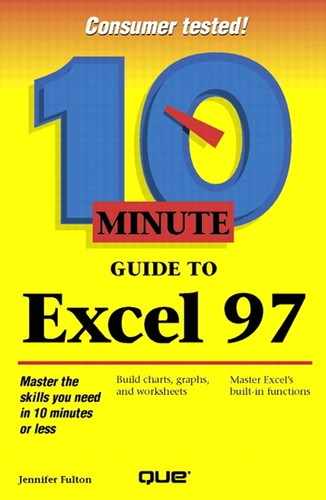Changing the Page Setup
A workbook is a collection of many worksheets, which are like pages in a notebook. You can print the whole notebook at once, or just one or more pages at a time.
Before you print a worksheet, you should make sure that the page is set up correctly for printing. To do this, open the menu and choose Page Setup. You'll see the Page Setup dialog box shown in Figure 11.1.
Figure 11.1. The Page Setup dialog box.

Right-Click the Workbook Title Bar
For quick access to commands that affect a workbook, right-click on the workbook's title bar. If the workbook is maximized to a full screen (and the title bar is therefore not visible), right-click the Control-menu box to access the shortcut menu. For example, to check the page setup, right-click the title bar or the Control-menu box and choose Page Setup.
The following list outlines the page setup settings, grouped according to the tab on which they appear.
Page tab
Orientation Select Portrait to print across the short edge of a page; select Landscape to print across the long edge of a page. (Landscape makes the page wider than it is tall.)
Scaling You can reduce and enlarge your workbook or force it to fit within a specific page size (see Lesson 12).
Paper Size This is 8 ½ × 11 inches by default, but you can choose a different size from the list.
Print Quality You can print your spreadsheet in draft quality to print quickly and save wear and tear on your printer, or you can print in high quality for a final copy. Print quality is measured in dpi (dots per inch); the higher the number, the better the print.
First Page Number You can set the starting page number to something other than 1. The Auto option (default) tells Excel to set the starting page number to 1 if it is the first page in the print job, or to set the first page number at the next sequential number if it is not the first page in the print job.
Margins tab
Top, Bottom, Left, Right Youcan adjust the size of the top, bottom, left, and right margins.
Header, Footer You can specify how far you want a Header or Footer printed from the edge of the page. (You use the Header/Footer tab to add a header or footer to your workbook.)
Center on Page You can center your workbook data between the left and right margins (Horizontally) and between the top and bottom margins (Vertically).
Header/Footer tab
Header, Footer You can add a header (such as a title) that repeats at the top of each page, or a footer (such as page numbers) that repeats at the bottom of each page. See Lesson 12 for more information on headers and footers.
Custom Header, Custom Footer You can use the Custom Header or Custom Footer button to create headers and footers that insert the time, date, worksheet tab name, and workbook file name.
Sheet tab
Print Area You can print a portion of a workbook or worksheet by entering the range of cells you want to print. You can type the range, or click the Collapse Dialog Box icon at the right of the text box to move the Page Setup dialog box out of the way and drag the mouse pointer over the desired cells (see Lesson 12). If you do not select a print area, Excel will print either the sheet or the workbook, depending on the options set in the Page tab.
Don't Print That!
Ordinarily, if there's a portion of your worksheet that you don't want to print, you can avoid it by selecting the area you want to print and printing only that selection. However, if the data you want to hide is located within the area you want to print, what do you do? In that case, you can hide the columns, rows, or cells to prevent them from being printed. (See Lesson 2 for help.)
Print Titles If you have a row or column of entries that you want repeated as titles on every page, type the range for this row or column, or drag over the cells with the mouse pointer (see Lesson 10).
Print You can tell Excel exactly how to print some aspects of the workbook. For example, you can have the gridlines (the lines that define the cells) printed. You can also have a color spreadsheet printed in black-and-white.
Page Order You can indicate how data in the worksheet should be read and printed: in sections from top to bottom or in sections from left to right. This is the way Excel handles printing the areas outside of the printable area. For example, if some columns to the right don't fit on the first page and some rows don't fit at the bottom of the first page, you can specify which area will print next.
When you finish entering your settings, click the OK button.
